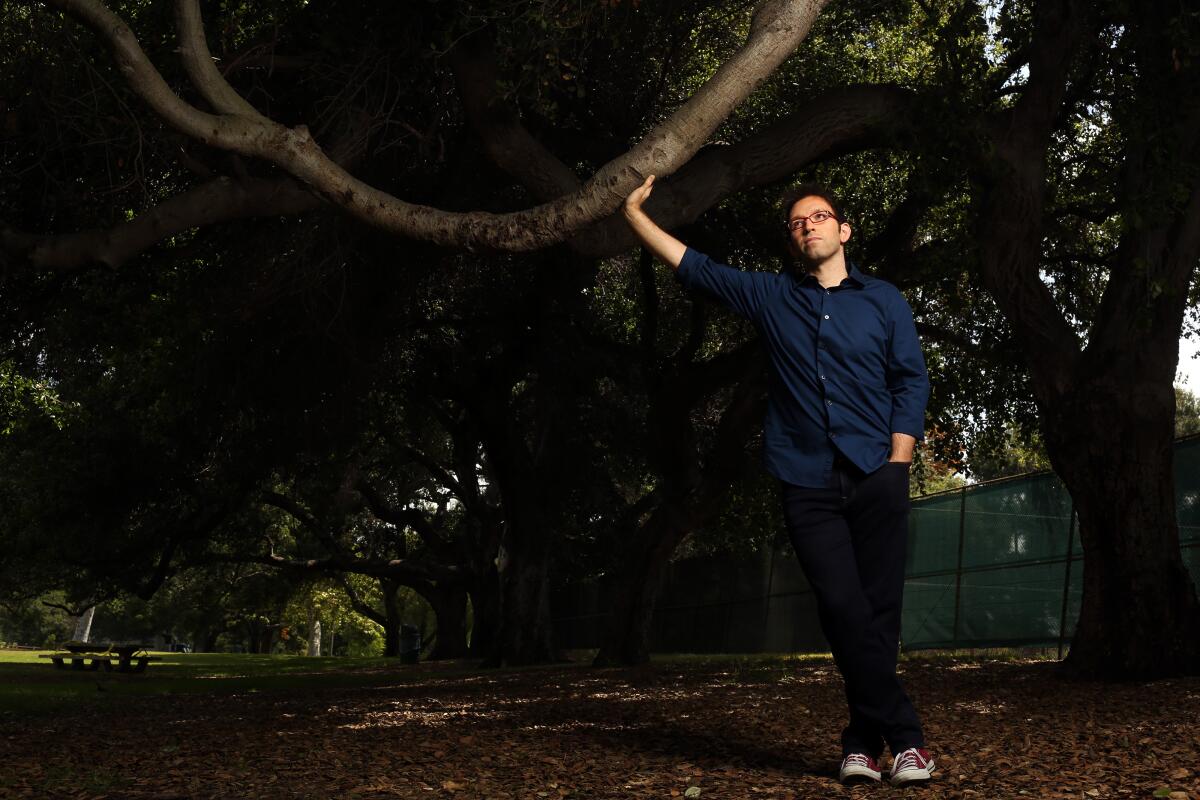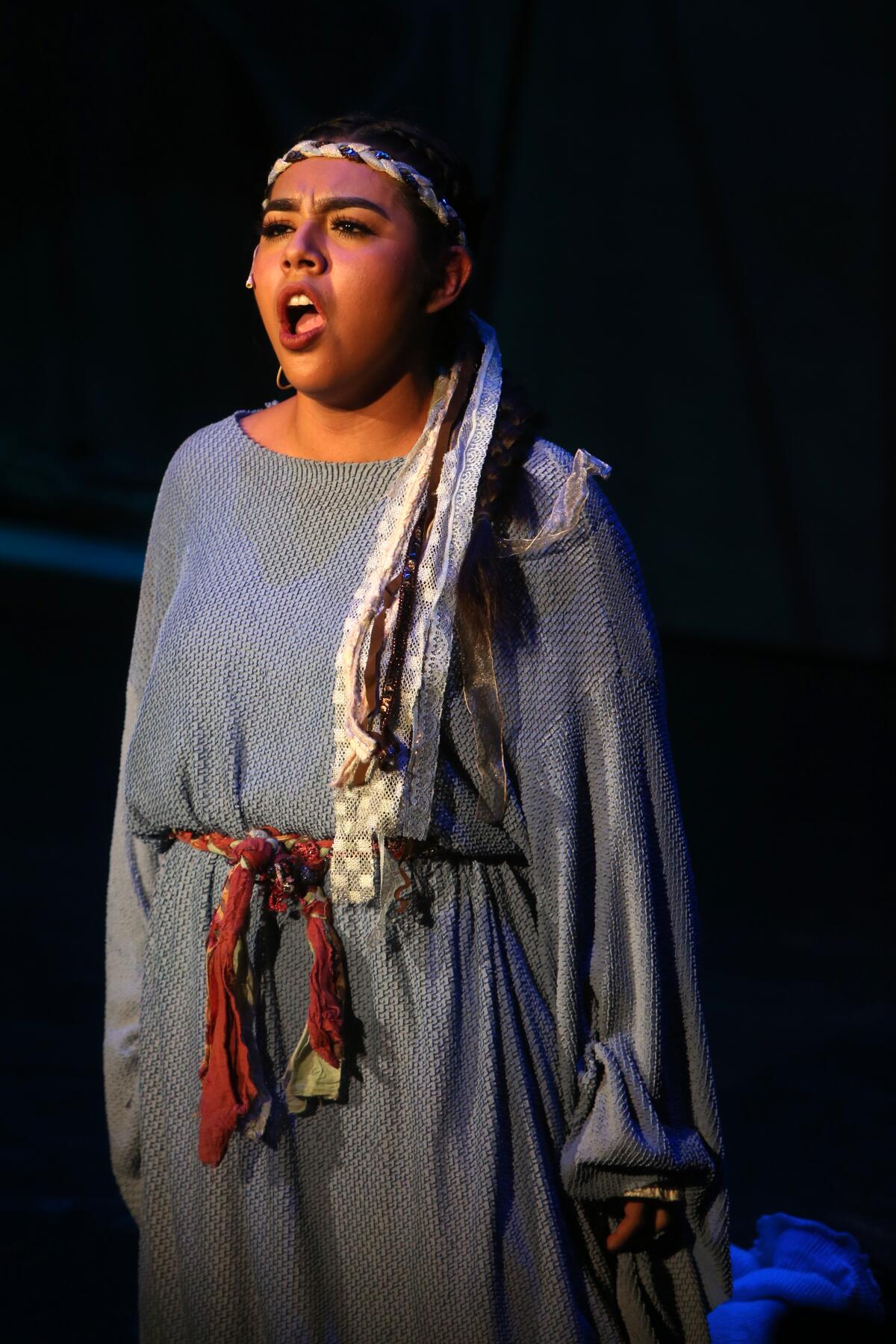Essential Arts: To spend, or not to spend, the museum endowment
- Share via
You’re here. And I’m here. Which makes it a fine time for an arts newsletter. I’m Carolina A. Miranda, shaggy staff writer at the Los Angeles Times, with your weekly delivery of essential culture news — and drive-by art shows.
Essential image
L.A. painter Jennifer Guidi opened a solo show, “Gemini,” at one of Gagosian’s New York outposts in late February ... and I don’t need to tell you what happened next.
The artist creates deeply textured paintings (often incorporating sand) that draw from abstraction, textile traditions and color theory, among other themes. For this exhibition she explores ideas of duality (inspired by her astrological sign). The show includes two horizontal landscapes, one of which is featured above, that dwell on those transitory moments known as dusk.
You can see more work by the artist on Gago’s website. The artist has also compiled a playlist of what she’s listening to when she works in the studio.
Money troubles
The American Alliance of Museums estimates that U.S. museums are collectively losing $33 million a day. Which raises the question of those multimillion-dollar endowments. Should some wealthy institutions, such as the Metropolitan Museum of Art, which has a $3.6 billion fund, dip into their kitties? Or should endowments be preserved to help assure the future of the institution? And what about restricted funds? The Times’ Deborah Vankin has an essential explainer.
Make the most of L.A.
Get our guide to events and happenings in the SoCal arts scene. In your inbox every Monday and Friday morning.
You may occasionally receive promotional content from the Los Angeles Times.
Dana Kopel, who was furloughed from the New Museum of Contemporary Art in New York, writes about the inequities the furloughs have revealed: “I am not interested in asking what art looks like in these uncertain times. I want answers to other questions. What does art look like when you can’t pay rent? What does art look like when you’re too sick to get out of bed, and too broke to go to the hospital?”
Plus: A look at some of the curatorial work that has been lost as a result of the pandemic.
The arts and coronavirus
The Hollywood Bowl has canceled its season for the first time in 98 years, reports Jessica Gelt — and summer will simply not be the same. “It’s a devastating blow to our organization,” says Chad Smith, chief exec of the L.A. Phil, which manages the Bowl.
In a separate report, Gelt notes that the cancellation will generate a chain reaction in other parts of L.A.’s performing arts ecosystem. The Hollywood Bowl Orchestra (65 musicians and staff) will be furloughed, as will 226 seasonal employees. The L.A. Phil is facing an $80 million budget shortfall and will draw $20.6 million from its endowment to help plug the gap.
The opening of “Hamilton” at the Hollywood Pantages has been pushed back to Sept. 6. The good news is that the engagement has been extended through February of next year.
On the other hand, “Hamilton,” the movie, which stars creator Lin-Manuel Miranda in the title role, will arrive early. Way early. The film had been scheduled for release in late 2021. Instead, it will debut on Disney+ this July 3. Times theater reporter Ashley Lee says the decision is a “bold move that makes theater more financially accessible to the masses.” But only if you are a Disney+ subscriber.
The film will certainly give theater lovers something to soak up over the summer because Broadway will remain shuttered through Labor Day. Touring productions, however, will each decide, on a case-by-case basis, whether to reopen in conjunction with hosting venues.
Speaking of theater, critic Charles McNulty checked out “The Present,” Helder Guimarães‘s virtual magic performance for the Geffen Playhouse — a work McNulty describes as “the closest approximation I’ve had to being in a theater since the pandemic closed the venues.” Guimarães, he adds, is “a magician Jorge Luis Borges might have dreamed up.”

Incidentally, the New Yorker’s Alexandra Schwartz also found an online work she was quite beguiled by: Richard Nelson’s “What Do We Need to Talk About?” In the work, commissioned by New York’s Public Theater, she reports that Zoom wasn’t an “irritating technical compromise but an integral plot point.”
Related: McNulty sat in on a videoconference organized by L.A. Theatre Speaks in which theater directors talked about creating stage content for online platforms. He examines the challenges these productions face — but also what it means for theaters to have audiences “grow accustomed to watching plays and musicals on their devices.”
Makeda Easter likewise reports on how dance companies are going virtual to survive. “There is no going back to normal,” says Laura Karlin, director of Invertigo Dance Theatre.
“Let’s bring the house concert into the twenty-first 21st century.” Alex Ross profiles classical pianist Igor Levit, who has staged dozens of impromptu concerts online since the lockdown began in Germany, in the New Yorker.
For the students at the Los Angeles County High School of the Arts (LACHSA), Ramón C. Cortines School of Visual and Performing Arts (Grand Arts High School) and other arts-focused schools, “their lost performances go beyond the disappointment of not being able to share their work with family and friends,” reports The Times’ Dorany Pineda. “The arts, after all, are not electives for them but potential careers.” Pineda explores what the pandemic means for arts students.
For a related profile, she spends time with LACHSA student Estefani Lopez, who used to make the daily trek from Riverside to L.A. to study music. She now studies remotely on Zoom and is rehearsing for a virtual version of “West Side Story.”

Contributor David Pagel ponders the contradictions of teaching a physical medium such as art online. “The technology we use to maintain a safe distance ..., “ he writes, “makes its own ‘artistic’ decisions: deleting details, editing experiences, changing colors, shifting scale and dimension.”
For her exhibition at A-B Projects, artist Phoebe Cummings created sculptures out of raw clay that would decay over the show’s run. The show was cut off by the safer-at-home orders, but the works remain in place as a curious memento mori, writes contributor Leah Ollman, “a reminder of the transience of beauty and life itself.”
Dispatches from hither and yonder
Governor Newsom has OK’d the re-opening of outdoor museums in California — but L.A. County, which has been hardest hit by the pandemic, “may go a little slower than the state” said L.A. County Public Health Director Barbara Ferrer. And then there is the question of what qualifies as an outdoor museum.
But you needn’t wait for the museums to open. The artist-run space Durden and Ray has organized installations of outdoor works around the city that you can see on a walk or from your car. “We Are Here / Here We Are” gets rolling Saturday. Check its website for a map of locations.
In the meantime, museums in Europe have begun to reopen with new rules that include one-way routes and obligatory face masks.
More than 200 arts leaders in New York have been gathering for a daily Zoom call to exchange ideas, tips and mutual support in the midst of the pandemic.
Enjoying this newsletter? Consider subscribing to the Los Angeles Times
Your support helps us deliver the news that matters most. Become a subscriber.
In late April, the city of Vilnius, Lithuania, announced plans to turn over streets and squares to restaurants and cafes to allow them to operate with adequate social distancing. Now Berkeley has introduced legislation for a similar option. And San Jose has announced a program that will allow businesses such as restaurants to occupy parts of streets and parking lots. What say you, L.A.? Turn Melrose into an outdoor cafe?
Art critic Martin Herbert writes about why the art world needs to take a break: “In the art world and outside of it, I suspect most of us spend more time on intake than contemplation.”
Jerry Saltz on deli coffee and and the Art Institute of Chicago and Wheat Thins and cancer and COVID-19. Somehow it all comes together.
Citylab rounds up maps of life under lockdown.
The best arts online
Looking for some good streams? Matt Cooper has the latest, including a free, 48-hour stream of a performance of “Cats” (the theatrical work, not the movie), a performance of Nora and Delia Ephron’s monologues piece “Love, Loss & What I Wore” featuring Carole Kane and Tracee Ellis Ross, and a virtual festival of dance films organized by Dance Camera West.
You can find his regular missives at “Things to Do: Arts and Culture.”
The newly formed Gallery Association Los Angeles has just launched galleryplatform.la, which will feature rotating exhibitions by L.A. galleries. The first show features work from artists represented by 1301PE, Jeffrey Deitch, Park View / Paul Soto, Vielmetter Los Angeles and many more.
Arts writer Jillian Steinhauer rounds up a list of five artists to follow on Instagram. And New York’s New Museum has launched “Bedtime Stories,” an online initiative organized by artist Maurizio Cattelan that features a crew of collaborators (including Iggy Pop and Abraham Cruzvillegas) reading selections from their favorite books.
The museums are getting boozy. The Getty has posted recipes for cocktails inspired by ancient art. (Though, seriously, Getty mixologists, I gotta go find saffron in the middle of a pandemic?)
For parents: The way to San Jose is through a new coloring book.
Passages
Thomas Sokolowski, the longtime director of the Andy Warhol Museum, who led some of the art world’s early responses to the AIDS crisis, has died at the age of 70.
In other news
— “It’s time to take California back from Joan Didion,” writes Myriam Gurba.
— A new doc, “Marius Petipa: The French Master of Russian Ballet,” explores the legacy of the legendary 19th century choreographer.
— The Huguenot smallpox doctor who was an early librarian at the British Museum. With shout-outs to Voltaire and a murderous portraitist.
— The Getty Research Institute has acquired the archive of Rachel Rosenthal, a key player in the theater, feminist and performance art scenes in 20th century L.A.
— Alex Beam on how Mies van der Rohe’s Farnsworth House got built. (Hint: Very contentiously.)
— And walker David Ulin writes on books about walking.
Last but not least ...
I’m here for any comedy routine that somehow brings the Sinaloa Cartel and Amazon labor practices together into one punchline.
The biggest entertainment stories
Get our big stories about Hollywood, film, television, music, arts, culture and more right in your inbox as soon as they publish.
You may occasionally receive promotional content from the Los Angeles Times.




